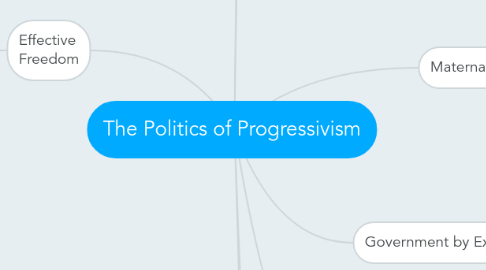The Politics of Progressivism
作者:Josephine Du [Student FVHS]


1. Effective Freedom
1.1. Cities around the world had progressive movements
1.1.1. NYC Chicago and Philadelphia
1.2. Progressivism started in Europe and moved to America
1.2.1. pensions minimum wage laws and unemployment insurance were given to workers.
1.3. government should be active and socially conscious
1.3.1. its role is to stop giant corporations help consumers civilize the market and guarantee freedom
1.4. Randolph Bourne: cooperation between industry and social institutions
2. The Campaign for Women's Suffrage
2.1. National American Woman Suffrage grew to 2 mill. (1917)
2.2. Wyoming, Colorado, Idaho, Utah had women’s rights
2.3. Accused for trying to lure in women (These states had low pop. of women, high men pop.)
3. State and Local Reform
3.1. ok
3.2. Robert M. La Follette- Most influential Progressive at state level
3.3. Progressive to reform monopolies, gov’t, political bosses, transportation, & school
4. Progressive Democracy
4.1. Progressives want greater democracy b/c political reforms=unification & greater democracy
4.2. 17th amendment-U.S. senators chosen by popular vote>state legislature
4.3. Restrictions in democracy: blacks no suffrage in South; literacy & residency tests, (restricted poor)
5. Government by Expert
5.1. Order, efficiency and centralized management for social injustice
5.2. Drift
5.2.1. Continuing to operate with the outdated belief in individual autonomy
5.3. Mastery
5.3.1. Using science to solve social problems
5.4. The educated were more suited to solve America’s problems
6. Jane Addams and the Hull House
6.1. Organized women reformers who spoke for the democratic side of Progressivism
6.1.1. Middle class women
6.2. Settlement houses
6.2.1. Ex. Addam’s Hull house
6.2.2. Helped immigrants and women.
6.2.3. Immigrants lost their culture
6.3. Addams: educated and working
7. Spearheads for Reform
7.1. Other name for settlement houses
7.1.1. produced Middle-class women
7.2. Gov intervention in social issues
7.3. Fix sanitation, work hours, work conditions, and unions.
7.4. Stop child labor
7.4.1. 1903 AL: child labor banned
7.4.2. 1915: child labor banned in all southern states
7.5. National Consumer’s League
7.5.1. By Florence Kelley
7.5.2. Regulate women and child labor.
8. Maternalist Reform
8.1. Domestic role of women pushed suffrage agenda
8.2. Wanted women having kids while being economically free.
8.3. Government allowed less working hours for women because of natural inferiority
8.3.1. 1908: Muller vs Oregan
8.3.2. 1917: 30 states support

